 WEE BEASTIES
WEE BEASTIES
 WEE BEASTIES
WEE BEASTIES
Entomology Newsletter for Teachers
Volume 1, Issue 2 University of Kentucky – Department of Entomology Fall 1998
From the Editor's Desk Fall '98 KTLN Teacher In-Service Training Opportunities
Go to top
 We are continuing to offer Teacher In-Service Training programs through the KTLN (Kentucky TeleLinking Network) sites. This fall we are offering two different training opportunities. "Incredidible Insects" will be offered October 5, 1998, 4-6 pm (Eastern), and "How to Build a Better Bug Box" will be offered October 19, 1998, 4-6 pm (Eastern).
We are continuing to offer Teacher In-Service Training programs through the KTLN (Kentucky TeleLinking Network) sites. This fall we are offering two different training opportunities. "Incredidible Insects" will be offered October 5, 1998, 4-6 pm (Eastern), and "How to Build a Better Bug Box" will be offered October 19, 1998, 4-6 pm (Eastern).
The objectives of the "Incredible Insects" training session are to give educators basic information about insects, tips on maintaining insects in the classroom, and several classroom activities which will help students understand the importance and diversity of the insect world. Topics covered will include structure, development, and metamorphosis, classifying insects, insect defense, collecting and caring for insects, and insects in the classroom.
"How to Build a Better Bug Box" will help teachers learn the proper techniques involved in creating insect collections. Entomology Specialists will show you how to collect, kill, pin, mount, label and identify your insects and go over some additional activities such as making your own killing jars and insect nets. Making an insect collection is the best way to learn about what insects look like, where they live, and what they do. A collection will also help you and your students tell others what you have learned about insects.
You can attend a training session in any county that has a KTLN site. KTLN uses interactive video, audio, and data to link sites throughout the Commonwealth of Kentucky. If you would like to participate, please see the KTLN Session Calendar web site for further information.
Entomology faculty members will be present at as many participating sites as possible. They will bring hands on activities as well as some live insects. This training sessions will also allow teachers to identify colleagues across the state with an interest in entomology and increase the opportunity for collaborative learning (e.g. future KTLN sessions with multiple classes of students participating.)
Acorns For Rent
Go to top
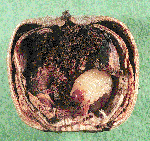 As Autumn approaches, the leaves begin to change colors and fall from the trees. Every year acorns, which are found on the ground at the base of large oak trees, become temporary homes for insects.
As Autumn approaches, the leaves begin to change colors and fall from the trees. Every year acorns, which are found on the ground at the base of large oak trees, become temporary homes for insects.
Acorn weevils overwinter in the ground. In the summer, they emerge to look for a mate. Mating usually takes place very soon after the weevils emerge. The female acorn weevil uses the small jaws at the end of her long snout to drill a hole in the shell of the developing nut. Then she backs up and lays 2 to 4 eggs inside. The young acorn weevil larvae hatch inside the acorn after one or two weeks. The larvae develop inside the acorn, feeding on the nutmeat for about 3 weeks. The more larvae inside an acorn, the slower they develop because they must share the available food.
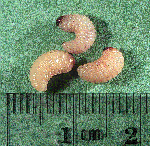
The infested acorn falls from the tree about the time that the weevil larvae are fully-grown. When the acorn hits the ground, it is a signal to the acorn weevil larvae that it is time to chew their way out. This process can take from 2 hours to 3 days, depending on the thickness of the acorn shell. Once the acorn weevil larva breaks free of the acorn, it tunnels down into the ground and makes an earthen cell in which to spend the winter. The larva will stay in its winter home for up to 5 years before it emerges one summer as an adult acorn weevil.
Not all acorns are infested with acorn weevils. You can easily determine if the insects are present is placing the acorns in water. The uninfested acorns will sink to the bottom. If an insect has hollowed out an acorn it will float.
For some fun activities that you can do with acorns see UK Entomology Youth Fact entitled
"Acorns For Rent" Students are often surprised that many insects can be found in hiding places right before their eyes if they just knew where to look.
Unwelcomed Insect Visitors in the Classroom
Go to top
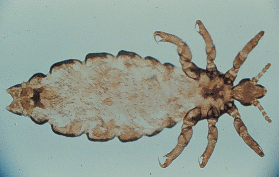
To get rid of head lice, the child or infected person(s) should be treated with a pediculicide shampoo formulated specifically to control lice. All nits (louse eggs) must be removed with a fine-tooth louse comb and all personal articles that have been in contact with the infected person's head should be deloused. To reduce the chance of reinfestation, children should be instructed not to share hats, clothing, or brushes with their classmates. For more information on the elimination and prevention of head lice, see UK Entfact "Management of Head Lice"
Although head lice can be a nuisance, with proper treatment and changes in habits they can be controlled.
IPM in the Outdoor Classroom
Go to top
By Patty Lucas, IPM Specialist
Thinking of developing an outdoor classroom next spring - now is the time to begin incorporating IPM, Integrated Pest Management, into your curriculum.
Whether the outdoor classroom is a butterfly garden, a vegetable garden or an area used to grow native plants, using IPM techniques can enhance your students learning opportunities.
Integrated Pest Management is a program that can help students understand the relationship between plants and the environment. The techniques of Integrated Pest Management (IPM) have been used for over 20 years in Kentucky mostly in field crops. IPM is designed to manage pests (weeds, diseases, and insects) so that economic damage and harmful side effects are avoided by using all available resources. For example, if you are planning an outdoor classroom now is a good time to have the soil tested for the area. Why soil test? Because plants have nutrient requirements and an optimum soil pH. Plants that are stressed or weak due to lack of nutrients or a low or high soil pH are more susceptible to disease and can not as readily tolerate insect damage.
Your local county extension office can provide the form, instructions, and a sample box for taking a soil sample. Many offices have soil probes that can be borrowed to use in taking samples. There is a small fee for processing the sample. Your soil sample will be mailed to the University of Kentucky Soil Testing Laboratory. Once the sample has been analyzed, a report will be returned to your local county extension office. Your local county extension agent for agriculture or horticulture can help you interpret the results of your sample.
Start your outdoor classroom out right by use IPM techniques such as soil testing.
Book and Video Review
Go to top
Bug Wise, Thirty Incredible Insect Investigations and Arachnid Activities, by Pamela Hickman (Addison-Wesley Publishing Company). This excellent activity book is written for ages 7 through 12. It includes a plethora of fun activities that allow kids to examine insects and spiders in their natural habitat. Activities are split into several sections including aquatic insects, insects in winter, investigating insects, some insects up close, insect survival, and insect imposters.
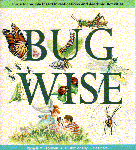
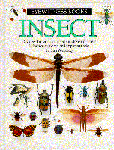

Eyewitness Books - Insect, by Laurence Mound, Alfred A. Knopf, New York. The illustrations in this book make it one of the best reference books on insects to have in the classroom. Some of the narration is written above the reading level of young scientists, but the quality and subject matter of the pictures are superb. This book covers most general entomology topics including first insects, eyes, legs, wings, senses, mothparts and feeding, major orders of insects, living with plants, camouflage, insect habitats, social insects and helpful versus harmful insects. There is also a video "Eyewitness Insect" that is based on the book. The 3-D graphics allow the viewer to feel like they are right in the middle of the action.
Did You Know?
Go to top
* Some of the largest insects living today include Malaysian walking sticks that can be up to a foot long and the Atlas moth from Australia that has a 14-inch wingspan.
* The kissing bugs of South and Central American ingest 12 times their body weight in blood during one feeding. That would be like a person drinking 200 gallons of milk in one sitting.
A Note from the Editor:
Go to top
If you have ideas, experiences, or information that you would like to share or would like information about educational resources available through the University of Kentucky, Department of Entomology, write or email the editor:
Editor, Wee Beasties Newsletter
Department of Entomology
S-225 Agriculture Science Center - North
University of Kentucky
Lexington, KY 40546-0091
Email: blnewt00@uky.edu
View and print Wee Beasties in the Adobe Acrobat (tm) PDF format. The Adobe Acrobat (tm) PDF format allows you to download, view, search, and print, while maintaining the original printed look of the document.
Go to top
Educational Programs of the Cooperative Extension Service serve all people regardless of race, color, age, sex, religion, disability, or national origin. UNIVERSITY OF KENTUCKY, KENTUCKY STATE UNIVERSITY, DEPARTMENT OF AGRICULTURE AND KENTUCKY COUNTIES COOPERATING.